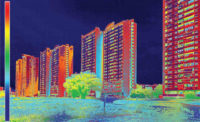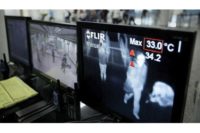Applications Heat up for Thermal Imaging Cameras

In addition to lower purchase costs, thermal cameras are becoming easier to install and more maintenance-free.
PHOTO COURTESY OF SIGHTLOGIX

Integrators can use portable handheld thermal thermometers to monitor the operating temperature of vital equipment in the field, allowing any issues to be addressed more quickly to maximize the uptime of security systems.
PHOTO COURTESY OF FLIR SYSTEMS


Driven by lower costs for micro bolometers, image sensors, lenses and other components, the price of thermal cameras continued to drop as expected in 2014. Lower camera costs translate into lower barriers to entry for thermal imaging, which has in the past been prohibitively expensive for many potential end users.
Today, costs are a fraction of what they were even a few years ago and continue to go down,” says Matt Bretoi, vice president, North America field sales, for FLIR Systems, based in Wilsonville, Ore. “This has gone a long way to put the technology into the hands of everyday applications and to be more and more frequently the economical choice.”
The expanded base of potential customers could represent a major opportunity for systems integrators to earn additional revenue by presenting thermal cameras as a cost-effective solution.
“Thermal imaging can lower installation and infrastructure costs, as well as be a low-maintenance alternative to other detection technologies,” Bretoi says. “Additionally, it provides inherent visual verification and assessment in one package.”
In order to make good business decisions around thermal, it’s important that integrators have a good understanding of how the market evolved last year and where it may be headed in 2015.
For now the most common thermal imaging application is perimeter protection, which has been made more effective with the integration of video analytics. Thermal security cameras are replacing other technologies, for perimeter security because of their ability to provide recognition in addition to detection.
“Customers are using thermals for perimeter protection, where the cameras may act as an invisible fence for discreet surveillance,” says John Merlino, business development, manager, government, for Chelmsford, Mass.-based Axis Communications. “This is often a more cost-effective solution compared to alternatives such as radio frequency intruder detection (or RAFID), electrified fencing, expensive underground magnetic pulse or conventional security cameras combined with floodlights.”
In addition to their high costs, thermal cameras in the past had a tendency to be plagued by the potential to provide washed-out images during the brightest part of the day when the sun would heat the entire scene to a uniform temperature, resulting in blurring. A similar result often would occur at night when the difference between background and target temperatures would be virtually indistinguishable. The reason for this was that previous thermal imaging cameras simply lacked the processing power to compensate for small temperature differences between a person or object and the background. Further compounding the problem was the fact that applying video analytics to these blurred images would potentially cause events or targets to go undetected. Today’s cameras have overcome those limitations, says John Romanovich, CEO of Princeton, N.J.-based SightLogix.
“Now, when video analytics are integrated with thermal cameras that employ a combination of increased thermal imager sensitivity, enhanced image processing and video analytics optimized for the enhanced processing, thermal detection cameras are emerging as a 24-hour solution for the first time,” he says.
In the industrial and utility markets, a particular area of growth is the use of thermal cameras as sensors in SCADA (supervisory control and data acquisition) networks, which are used to monitor and control a plant or equipment. A SCADA system can be used to monitor environmental conditions, activity in a particular area of a plant or substation and much more, transferring data back to a central site and alerting when an unfavorable condition, such as overheating equipment, occurs. In light of this, the ability for thermal cameras to provide integrated solutions across back-end systems such as video management systems (VMS) and SCADA systems has become an increasingly more important application for thermal imaging.
The evolution of thermal imaging is occurring rather quickly. Among the most notable recent advancements has been an increase in image resolution, a larger number of features, and increasing compatibility and integration with other security technologies. Two main drivers for the significantly expanded use of thermal cameras stand out, according to Bretoi.
A main advancement is remote monitoring capability. Due to lower bandwidth usage and the fact that thermal imaging has grown into a 24/7 technology with no lighting requirements, thermal goes hand in hand with remote monitoring and video analytics, Bretoi says.
“Today, common applications include gated communities, auto dealerships, storage yards and parks, to name just a few. We see this as one of the strongest trends in thermal imaging, and one that will grow even faster in 2015.”
Looking Ahead
The coming year should see continued and dramatic advancements and growth in micro bolometer sensor technology, says David Dorn, applied technology engineer, Pelco by Schneider Electric, based in Clovis, Calif. These technologies are also expected to make their way into even lower-cost thermal and combination thermal-visible light cameras.
“The use of thermal cameras to provide situational awareness, in combination with visible light cameras, will increase the use of wide field-of-view thermal cameras,” Dorn says.
The cost of thermal cameras will likely continue to fall, further expanding the potential customer base for the technology, Romanowich adds.
“Customers will increasingly deploy these military-grade intrusion detection solutions to solve general problems that include theft and vandalism,” he says. “In effect, smart thermal cameras are expanding the function of a burglar alarm from inside the building to the perimeter with the same reliability and low costs that we expect from the alarm systems we use every day in our home and office systems.”
By nearly all accounts, 2015 will be another big year for thermal cameras. Integration with geospatial imaging is just one of the many possibilities, Merlino says. “Used in tandem with software that enables geospatial targeting, end users are picking up, interrogating, validating and identifying — in real time — threats and nuisances in their environment with greater clarity than ever before at a more reasonable cost,” he says.
Looking for a reprint of this article?
From high-res PDFs to custom plaques, order your copy today!










